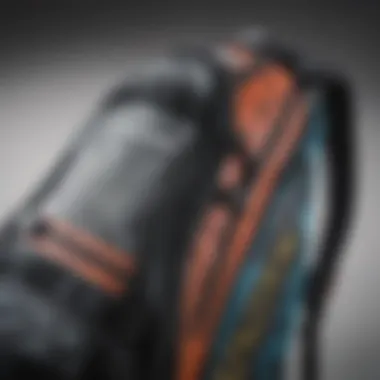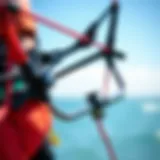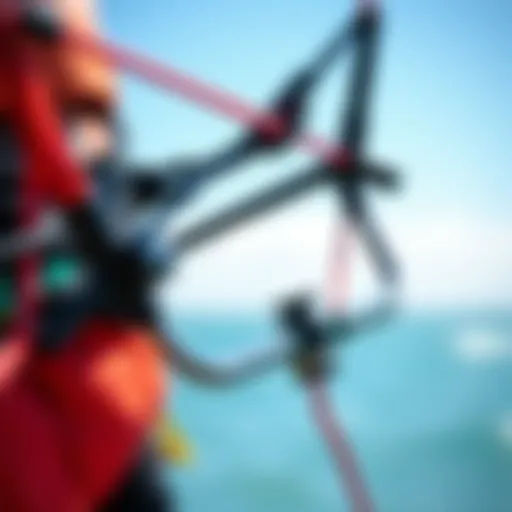Exploring Dakine Kiteboard Bags: Design and Features


Intro
Kiteboarding isn't just a sport; it's a lifestyle for many people. Whether you're cruising across the water or catching waves, having the right gear is paramount. Among the most crucial elements for every kiteboarder is a high-quality kiteboard bag. This article takes a closer look at Dakine kiteboard bags, which have earned a reputation for their durability and functionality. We'll explore the different types, features, and materials that Dakine offers, helping you make informed choices for your kiteboarding adventures.
Gear Selection
Choosing the right gear is essential for any kiteboarder. Good gear not only enhances performance but also ensures the safety and longevity of your equipment. Dakine packs an extensive lineup of kiteboard bags designed to meet diverse needs. Each bag is crafted to withstand the elements and protect your investment.
Types of Kites
Different kiteboarding styles require specific types of kites. Whether you're into freeride, freestyle, or wave riding, the type of kite can affect your decision on the right bag. Dakine offers bags for various kite dimensions, enabling you to find something that fits your preferred style.
- Freeride Kites: These kites are versatile and great for beginners. Look for bags that can accommodate more than one setup.
- Freestyle Kites: These kites are designed for tricks and stunts. Choose padded bags that offer extra protection during transport.
- Wave Kites: Ideal for riding larger waves. You might want a bag that’s narrower but longer for the optimal fit.
Consider what type of kite you usually ride and what will fit inside your Dakine bag to keep everything safe while traveling.
Choosing the Right Board
Selecting the right board isn't just about size—different boards function differently based on your skill level and riding style. Dakine kiteboard bags typically offer various compartments for your gear.
- Beginner Boards: Wider and more stable, these are easier to handle. A bag that can accommodate additional accessories may be beneficial.
- Intermediate Boards: A great balance of performance and stability, these boards can work with a range of bag styles.
- Advanced Boards: Designed for extreme maneuverability and speed; hence, a snug fit in the bag is essential to avoid any shifting during transport.
When you’re selecting your bag, think about how you will store extra accessories, such as harnesses or foot straps, since they can make a difference in convenience and organization.
End
Choosing the right kiteboard bag is more than just picking one off the shelf; it's about understanding how each model interacts with your gear and enhances your kiteboarding experience. Dakine kiteboard bags serve as an excellent choice for those looking to combine resilience with style. By considering your specific kiteboarding needs and preferences, you can find the optimal bag that fits all your equipment and ensures it stays protected while you chase the wind.
Prelims to Dakine Kiteboard Bags
When it comes to kiteboarding, the right gear is vital, not just for performance but also for protection during travel. Dakine kiteboard bags have carved a niche in this domain. They are known far and wide among kiteboard enthusiasts and professionals alike. But what sets these bags apart? The answer lies in their thoughtful design and the attention to detail that Dakine has consistently delivered over the years.
Kiteboarding often involves venturing to exotic locations, which can be both exhilarating and chaotic. Transferring equipment from one spot to another can lead to potential damages if it's not packed properly. A robust, well-structured kiteboard bag becomes an indispensable companion on these adventures.
There are several elements to consider when choosing a kiteboard bag, and understanding these can significantly enhance your experience. For instance, you'll want to think about padding and protection the bag offers, the material it's made from, and how well it accommodates your gear. Every aspect counts, from the durability of the zippers to how the seams are stitched.
One of the benefits of utilizing a Dakine bag is the brand's commitment to innovation. They understand the needs of kiteboarders and consistently adapt their designs, ensuring that what they offer is not just aesthetically pleasing but functional as well. For those who prioritize safety for their gear, knowing that your kiteboard and accessories are well-protected against bumps and scrapes can be comforting.
Moreover, this article aims to provide a comprehensive guide that will not only highlight the merits of Dakine kiteboard bags but also give you a broader perspective on their evolution as a brand, different types available, their key features, and more. By the end, you should have a clearer understanding of what makes Dakine kiteboard bags a preferred choice for many.
"Choosing the right gear is not merely a matter of preference; it can determine the peace of mind you have while kiteboarding across the waves."
In summary, the importance of Dakine kiteboard bags cannot be overstated. They represent a blend of quality, style, and thoughtful design, making them an optimal choice for kiteboarders of all levels. So as we delve deeper into the various aspects of these bags, keep in mind the specific qualities that can enhance your kiteboarding experience.
The Evolution of Dakine as a Brand
The evolution of Dakine as a brand is a fascinating journey that underscores its commitment to quality and innovation in the kiteboarding industry. Understanding the brand's history not only enriches the narrative around its products but also highlights the key principles that govern its manufacturing processes and design philosophies. For kiteboarders, instructors, and enthusiasts alike, this backstory offers profound insights into why Dakine kiteboard bags have earned a reputation synonymous with reliability and style.
History and Heritage
Dakine was established in 1979 on the beautiful Hawaiian island of Maui, where the sport of kiteboarding was beginning to take off. The name is derived from the Hawaiian word "dakine," which colloquially means "the best" or "the right one." This was no mere coincidence; it beautifully encapsulated the brand's vision right from the get-go. What started as a small company creating surf accessories quickly grew, thanks to a hearty blend of innovative designs and the insatiable passion of its founders for water sports.
Through the years, Dakine has not only catered to kiteboarders but has widened its scope by providing gear for various action sports, including snowboarding and windsurfing. This diversification has allowed them to hone their skills in material technology, enhancing the robustness of their products while ensuring they remain lightweight.
This brand has grown from its humble beginnings to a global presence, but always retained its roots in quality craftsmanship. Their manufacturing process is often looked at as a benchmark in the industry, and one can't speak about kiteboarding gear without mentioning this iconic brand. Dakine's bags are now recognized not just for their functionality but also for incorporating cutting-edge designs that reflect the lifestyles of passionate athletes.
Commitment to Quality and Innovation
Dakine's unwavering commitment to quality is evident in every stitch, and their innovative approach continually sets them apart in a crowded market. The brand prioritizes performance and is in constant pursuit of ways to improve their products.


"Quality is not merely a goal; it’s the foundation of our innovation."
One of the frequent critiques in the outdoor gear industry is how brands often rush products to market, prioritizing speed over quality. Dakine takes a different approach; they focus on extensive research and development. This ensures that each kiteboard bag is built to endure the rigors of travel and the tough conditions that come with the nature of kiteboarding. The use of durable materials not only extends the longevity of the product but also provides optimal protection for your gear.
Aside from durability, Dakine is known for incorporating customer feedback and real-world applications into their design process. This insistence on listening to the users’ voices results in features that authentically address the needs of kiteboarders.
With their storied past and a keen eye on the future, Dakine remains a trusted name among kiteboarders who prioritize reliability and performance in their gear.
Understanding Kiteboard Bag Types
When it comes to kiteboarding, selecting the right kind of bag isn't just about convenience—it's about protecting your prized equipment. Different types of kiteboard bags serve unique purposes, which can dramatically affect your overall experience while traveling or storing your gear. This section dives into the various types of kiteboard bags, focusing on their benefits and considerations, helping you make a well-informed choice for your next adventure.
Single vs. Double Bags
Choosing between single and double kiteboard bags is often the first big decision for those looking to store or travel with their equipment. On the surface, the distinction may seem small, but it can directly influence everything from mobility to organizational capability.
Single bags are designed to carry just one board. They're usually lighter and more compact, making them a practical option for those who prefer to travel light or have specific needs, like fitting into tighter spaces at the airport. If you're riding one board most of the time, a single bag is a sensible choice—not to mention it might save you a few bucks on baggage fees too.
On the other hand, double bags offer the ability to transport two boards at once, along with potentially more gear. This can include fins, harnesses, and even wet suits. For those who are serious about kiteboarding, or perhaps instructors managing equipment for lessons, a double bag can present a more efficient solution. While they can be bulkier and heavier, they provide the flexibility needed for anyone juggling multiple boards or traveling with a buddy.
Wheeled vs. Non-Wheeled Options
The decision between wheeled and non-wheeled kiteboard bags often boils down to how much you value mobility versus simplicity. Navigating through bustling airports or sandy beaches can turn into a chore if your bag isn’t designed for ease of transport.
Wheeled bags come equipped with sturdy wheels, providing significant ease when hauling gear over longer distances. This means no sore shoulders or struggling to balance a heavy load. Many kiteboarders appreciate the smooth roll of a wheeled bag, especially after a long flight or during a lengthy walk in sand. Just be aware that the wheels can add a bit of weight and might detract from the minimalist aesthetic.
On the flip side, non-wheeled options often allow for a sleeker design. They tend to be lighter and more streamlined, making them ideal for those who prefer to be nimble. However, you might find yourself carrying the weight directly, which can lead to uncomfortable situations if your bag is filled to the brim.
Ultimately, considering your travel habits, whether frequent trips or occasional journeys, can help dictate the best option for you. The right choice will not only protect your gear but also enhance your kiteboarding experience whenever you hit the waves.
"Selecting the right kiteboard bag is vital, not just for convenience but to ensure your gear is secure throughout your travels."
Choosing the right kiteboard bag type involves weighing practicality against personal preferences and usage patterns. Keep in mind that, regardless of your choice, investing in a high-quality bag—like those from Dakine—can make all the difference in keeping your equipment safe during your adventures.
Key Features of Dakine Kiteboard Bags
When it comes to choosing a kiteboard bag, those who know the sport understand that it's not just about having something to carry your gear. Dakine kiteboard bags are designed with features that cater to the specific needs of kiteboarders. This segment emphasizes the distinct elements that make these bags stand out, detailing how they blend functionality with durability, ultimately enhancing the user's experience.
Padding and Protection
Every kiteboarder is well aware of the risks involved in transporting gear. Padding plays a crucial role in protecting kiteboards from the dings and scratches that can occur during travel. Dakine takes this seriously. The interior padding of their kiteboard bags is often made from robust foam that absorbs shocks. It's not just about thick padding; the strategic placement of the padding ensures that high-impact areas—like the nose and tail of the board—receive extra attention.
Many users have found that their boards remain in pristine condition even after long journeys. It's like having a cozy blanket for your expensive kiteboard; should any unforeseen bumps occur, the protective layer cushions the blow. Additionally, the water-resistant materials used in these bags help to keep moisture away, ensuring that the boards remain safe even in less-than-ideal weather conditions.
Material and Durability
Speaking of materials, Dakine kiteboard bags are crafted with durability in mind. The outer fabric often features heavy-duty nylon, known for its resistance to wear and tear. Kiteboarding can be a rough sport, often involving sand, saltwater, and varied climates. With that in mind, the choice of materials ensures longevity. For instance, while some brands might skimp on canvas, Dakine employs robust fabrics that withstand the rigors of travel—be it a quick trip to the beach or an international flight.
"A kiteboard bag is an investment. With Dakine, it’s more than just a bag; it’s a fortress for your gear."
Moreover, the zippers and stitching are designed to endure constant use. Unlike flimsy cloth bags that tear or unzip at the first sign of strain, Dakine’s zippers are reinforced, making them less likely to fail.
Storage and Organization
Lastly, let’s talk storage. Having just space isn’t enough; it’s about smart storage solutions. Dakine kiteboard bags often come with multiple compartments and pockets. These thoughtfully designed features allow for better organization of accessories— like harnesses, fins, and leashes— so you aren't scrambling through a jumble of gear when you arrive at the kite spot. This organized approach is not just for convenience; it maximizes the available space, allowing kiteboarders to pack efficiently without the fear of damaging equipment.
Ultimately, when you dig deeper into the features of Dakine kiteboard bags, each characteristic—from padding and material to organization—reflects a dedication to quality that resonates with the kiteboarding community. This understanding fosters confidence for kiteboarders looking to protect their gear effectively.
Sizing and Fit for Your Gear
Selecting the right size for your kiteboard bag is not just a mere detail—it's a cornerstone of protecting your valuable gear during transport. For kiteboarders, understanding sizing and fit is crucial, as a poorly fitted bag can lead to unnecessary wear and tear, ultimately shortening the lifespan of your equipment. Whether you are an avid adventurer or an occasional kiteboarding aficionado, striking the right balance between convenience and security is vital.


Measuring Your Kiteboard
Before diving into the quagmire of finding the ideal bag, beginning with the basics of measuring your kiteboard is essential. Kiteboards come in various sizes, determined by both length and width, which can vary significantly across brands and models. To accurately measure your kiteboard, follow these simple steps:
- Use a Measuring Tape: Grab a standard measuring tape or ruler. Start measuring from the tail of the board to the nose, keeping it straight. This gives you the length.
- Measure the Width: For width, measure the widest part of your board. This helps determine how much room your bag will need to comfortably fit your gear.
- Consider Additional Gear: Don't forget about any additional items, such as the fins or pads. Make sure to account for them when measuring. It’s often wise to add a couple of inches to ensure you won’t be squeezing your gear into an overly tight space.
By taking these measurements, you can increase the likelihood of finding a bag that snugly fits without being too cramped.
Choosing the Right Bag Size
Once you have your board’s dimensions handy, the next step is to choose the right bag size. This might seem straightforward, but with the plethora of options available, it’s often easier said than done.
Start by checking out the specifications provided by Dakine or any other brand you might consider. Here are some factors to keep in mind:
- Single vs. Double Bags: If you have multiple boards, a double bag provides ample space while ensuring everything is packed safely. However, if you're a solo rider, a single bag designed for your specific board size might be the best route.
- Extra Space for Accessories: If you frequently carry extra equipment — like a wetsuit or a personal flotation device — it could be beneficial to opt for a bag that offers additional compartments or a bit more room.
- Style of Transportation: Think about how you typically travel. For those using a simple car transfer, bag size might not be as critical compared to someone taking a plane where strict regulations on bag dimensions exist.
Choosing the right bag size ultimately makes a world of difference in how hassle-free your kiteboarding journey becomes. It provides the necessary protection your gear requires while also making traveling a lot less cumbersome.
"The right kiteboard bag isn’t just about fit; it’s about peace of mind while you ride the waves, knowing your gear is safe."
With a properly sized bag in hand, you can focus more on enjoying the thrill of the ride rather than worrying about your equipment.
Travel Considerations for Kiteboarders
Traveling with kiteboarding gear can often feel like trying to herd cats. The excitement of an upcoming adventure is frequently paired with the anxiety over how to transport your precious equipment safely and efficiently. Kiteboarders must account for various factors when preparing for a trip, including airline rules, potential fees, and packing strategies. The right considerations can make the difference between a smooth journey and a chaotic one.
Airline Regulations and Fees
Airlines can be tricky, especially when it comes to transporting oversized sports equipment like kiteboards. Each carrier has its own set of regulations, which can lead to confusion if you're not up to speed. Here are a few critical points to keep in mind:
- Weight Limits: Most airlines impose strict weight limits for luggage, and kiteboards, combined with other gear, can quickly add up. Always check the specific airline’s policy so you're not caught off-guard with unexpected charges.
- Fees: Some airlines charge a fee for excess baggage, particularly for sports equipment. It's worth looking into these costs ahead of time, as they can vary significantly.
- Packaging Requirements: Airlines may specify how you should pack your board and associated gear. Certain airlines may require a hard case, while others might accept soft bags. Make sure you comply to avoid last-minute problems.
Consulting the airline’s website will be vital; many have detailed guidelines about traveling with sports equipment. Also, consider reaching out to customer service for clarification on any ambiguous policies.
Best Practices for Packing
Packing your kiteboarding gear isn’t just about cramming everything into your bag. A thoughtful approach can prevent damage and ensure that your gear is travel-ready. Here’s how to do it:
- Organize Your Gear: Begin by laying out all your equipment. This includes the kiteboard, harness, kites, bars, and any safety gear. Group similar items together.
- Use Protective Padding: Invest in additional padding for sensitive components like the kiteboard edges. Some kiteboard bags come with integrated padding, but adding foam or bubble wrap can provide extra security.
- Distribute Weight: When loading the bag, make sure to balance heavier items. Placing heavier objects towards the bottom ensures stability and prevents tearing or straining your bag during transit.
- Roll and Compress: For softer items like clothes or the kite, rolling them can save space and minimize wrinkles. Compression bags can be effective, but check if the airline allows them as they might raise the total bulk size of the luggage.
- Label Everything: Clearly label your bag with your contact information. This might seem trivial, but in case your bag goes missing, it may increase the chances of it finding its way back to you.
"Preparation is the key to getting a jump on potential travel headaches. A little thought can go a long way in keeping your gear intact."
Following these tips can streamline your travel experience, allowing you to focus on what really matters—enjoying your time on the water with your kiteboarding gear in tip-top shape.
Maintenance Tips for Longevity
When you're investing in quality gear like Dakine kiteboard bags, ensuring its longevity through proper maintenance is crucial. Frequent use, exposure to elements, and the occasional rough handling can put these bags to the test. Simple maintenance routines not only keep your bag looking fresh but also extend its functionality. A clean and well-maintained bag enhances your kitesurfing experience by safeguarding your gear and ensuring you’re ready for the next adventure.
Cleaning Your Bag
Cleaning your Dakine kiteboard bag regularly is essential. Sand, saltwater, and mud can build up over time, affecting the bag's material and structure. Here’s a practical approach to keeping your bag in tip-top shape:
- Rinse Off Good: After a day on the water, rinse your bag with fresh water. This helps remove salt and sand that could degrade the fabric over time.
- Use a Soft Brush: A gentle brush can help eliminate stubborn dirt without damaging the material. Make sure to use something soft enough to avoid scratches.
- Mild Soap Solution: If your bag is particularly dirty, a mild soap mixed with water can do wonders. Just be sure to rinse thoroughly to avoid soapy residues.
- Air Dry: Instead of putting it in the dryer, hang it outside or lay it flat away from direct sunlight. This prevents UV damage and helps maintain its integrity.
Regular cleaning can prevent a buildup of grime and ensure your gear stays protected. It’s like giving your bag a little TLC that pays off in the long run.
Storage Recommendations
How you store your Dakine kiteboard bag can greatly affect its lifespan. While it’s easy to toss it in a corner after use, adopting some solid storage practices is worth the effort:
- Keep It Dry: Moisture can lead to mold and mildew. Always ensure your bag is completely dry before storing it.
- Avoid Long-Term Compression: If you're not using your bag for a while, try to store it uncompressed. Things like using stuff sacks or other heavy tools can cause creases that might weaken the materials.
- Cool, Dark Place: Ideally, find a spot that’s cool and dark for storage. This keeps it away from harmful UV rays and extreme temperatures.
- Occasional Inspection: Give your bag a once-over now and then. Look for wear and tear, check the zippers, and ensure there are no rips or damages that might worsen when you next use it.


"A little diligence goes a long way; maintaining your bag is just as important as what you put inside it."
Comparing to Other Brands
When it comes down to kiteboarding gear, selecting the right equipment often feels like navigating a maze. Among the many factors influencing this choice, examining the differences between various brands can be crucial. In this section, we’ll dive into why comparing Dakine with other brands matters and what specific elements kiteboarders should take note of during their evaluation process.
Firstly, understanding the competitors is essential. The landscape of kiteboarding bags includes various players, each bringing something unique to the table. Brands like ION, Mystic, and Prolimit each have their own strengths and specialties, which makes it imperative for a kiteboarder to be aware of what’s on the market. Considering what Dakine offers versus these competitors involves more than simply considering price points. It’s about grasping the functionality, durability, and adaptability of each brand’s options to see how they resonate with different needs.
Additionally, features play a significant role. The construction quality of the materials, the thoughtful design elements, and how the bags hold up against the elements should not be overlooked. As a kiteboarder prepares for a day on the water, the bag they choose impacts how safely they transport their gear, and therein lies the value of making an informed comparison.
"A wise consumer doesn't just scratch the surface. They dig deep, studying the trenches where quality and design meet."
Key Competitors in the Market
In the kiteboarding arena, you’ve got several brands that have their hats in the ring. ION is known for its high-performance gear that appeals particularly to those who crave a cutting-edge design. Mystic, on the other hand, balances style with practical functionality, ideal for both weekend warriors and serious competitors alike. Then there's Prolimit, which may offer a more budget-friendly alternative without sacrificing too much on quality. Each of these brands has carved out its niche, presenting options that range from those suited to the casual user to equipment designed for serious athletes.
When comparing these brands against Dakine, think about your specific needs and preferences. Are you looking for a bag that can withstand heavy travel? Do you prioritize comfort and ergonomic designs? Or is style your main concern?
It’s these nuanced distinctions that can set a bag apart—something that can often go overlooked when merely glancing at prices.
Differentiating Features
What really differentiates Dakine kiteboard bags from its competitors? A few factors stand out here.
- Construction Quality: Dakine often uses a combination of high-denier fabrics and reinforced seams. This ensures greater longevity in harsher conditions, standing up to rigorous usage.
- Design Innovation: The unique organizational aspects, like specialized compartments and easy-access pockets, mark Dakine’s offerings. This could be vital on the beach where you don’t want to waste time rummaging around.
- Ergonomics and Comfort: When it comes to bag design, comfort plays a puckish role. Dakine folds this in thoughtfully, from the padded straps to the adjustable settings, making it less of a chore to carry around.
- Versatility: These bags often accommodate not just kiteboards but also other essentials like wetsuits and harnesses, which can make a world of difference when packing for a kite trip.
While no brand is without its faults, and some users might find Dakine's bags pricier, the long-term value offered through durability and effective design is something many seasoned kiteboarders feel justifies the investment.
In wrapping up, taking the time to compare Dakine to others can pay off in spades, as kiteboarding is not just a hobby but a lifestyle for many. Making an educated decision based on personal needs and practical offerings ensures that time on the water is spent enjoying, not worrying about gear mishaps.
User Experiences and Testimonials
When it comes to gear like kiteboard bags, there's no better perspective than that of the users themselves. Exploring user experiences and testimonials offers a genuine insight into the practicality and performance of Dakine kiteboard bags. This part of the article focuses on the real-world functionality that the technical specifications often can’t capture. Understanding how fellow kiteboarders view their Dakine bags enriches our knowledge about usability, reliability, and durability, essential elements for anyone making a purchasing decision in the kiteboarding world.
Often, riders at every skill level rely on shared experiences. The stories and feedback help paint a broader picture that can either bolster confidence in a product or raise red flags. For instance, users frequently highlight how crucial a well-padded bag is during travel, particularly when dealing with rough handling by airlines. Those who have purchased Dakine bags report their effectiveness in safeguarding against bumps and scrapes, translating into peace of mind while traveling.
Moreover, testimonials reveal varied perspectives, providing a well-rounded understanding of the product. When consumers detail their adventures, sharing tales of how their bags held up under different conditions—whether that's on the rocky shores of Hawaii or the bustling beach scene of Tarifa—they provide valuable information for potential buyers.
"It’s reassuring to hear that Dakine bags not only survived my numerous trips but actually kept my gear in pristine condition. The padding is a godsend!"
– A satisfied customer on Reddit.
Positive Feedback
Many users are quick to commend the build quality and thoughtfully designed features of Dakine kiteboard bags. Unsurprisingly, a recurring theme revolves around the level of protection provided by the bags’ padding. Users point out that during international travel, their gear arrived unscathed, thanks to the robust materials and designs Dakine employs.
- Durability: Riders frequently mention that the fabric remains intact even after multiple seasons of rigorous use, proving its resilience against wear and tear.
- Organization: Positive reviews consistently highlight the array of pockets and compartments that facilitate organized storage. Users appreciate not having to rummage through their bags—knowing exactly where to find fins or harnesses.
- User-friendly Design: Many testimonials focus on the bags being easy to carry, particularly the wheeled versions, enabling effortless navigation through busy airports or sandy beaches.
These satisfactory experiences not only elevate Dakine’s reputation but also affirm the brand’s commitment to crafting functional and reliable products.
Common Criticisms
However, like all products, Dakine kiteboard bags aren't without their critics. Some users have expressed frustrations worth noting, which may inform potential buyers of areas to consider before making a purchase.
- Weight Concerns: A number of consumers have noted that some models can be somewhat heavy, especially when factoring in the kiteboard and additional gear. This can be particularly challenging for those needing to adhere to strict airline weight limits.
- Price Point: While many agree that the bags are high-quality, some have voiced concerns regarding the price. For budget-conscious kiteboarders or newcomers to the sport, the cost of Dakine bags can be prohibitive.
- Limited Adjustability: Certain users wish for more adjustable options within the straps, making fittings more customizable depending on the size of the rider or the amount of gear to be stored.
By capturing both praises and criticisms, this section ultimately assists readers in navigating their choices with their eyes wide open. Gauging real users’ perspectives helps bolster informed decisions, ensuring that the investment aligns with their specific needs in the kiteboarding experience.
Epilogue
Understanding the essence of Dakine kiteboard bags is not just about knowing which product to choose. It’s about grasping how these bags can protect your gear and enhance your time on the water. Kiteboarding is a lifestyle that demands durability from equipment, and the right bag can make all the difference in ensuring that your kiteboard remains in pristine condition.
In essence, a quality kiteboard bag serves multiple purposes — safeguarding your gear during travel, offering adequate storage, and contributing to the overall ease of transport. Dakine's commitment to quality material and thoughtful design makes their bags a worthy investment. With options tailored to different needs, whether you're a weekend warrior or a seasoned pro, there's likely a Dakine bag that fits your kit like a glove.
When choosing a bag, consider the specifics: What size do you need? Will you be flying with it? These factors can change your selection significantly. Remember, the right bag is as crucial as the gear you carry inside it. Your boards, kites, and accessories are a financial commitment, and without proper protection, that investment could risk damage or, worse, loss.
Ultimately, this article serves to provide the kiteboarding community with a clear lens through which to view the options available, encouraging informed choices. Whether you’re looking for something durable, easy to carry, or spacious enough to hold all your gear, it’s essential to weigh these factors. There's a world of kiteboarding adventures waiting for you, and having the right tools—like a reliable Dakine kiteboard bag—can ensure that you hit the water without a hitch.
Protecting your investment with a quality bag isn't just a choice; it directly influences your performance and enjoyment on the water.
By making an informed decision according to your needs, you ensure that each kiteboarding session is full of excitement rather than fret about the safety of your gear.















